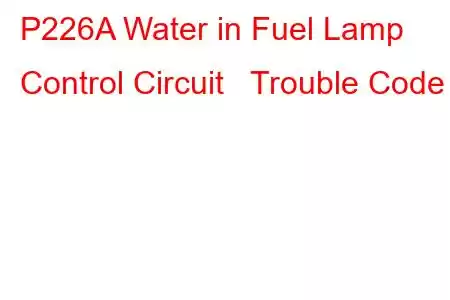P226A Water in Fuel Lamp Control Circuit
OBD-II Trouble Code Technical Description
Water in Fuel Lamp Control Circuit
What does that mean?
This is a generic diagnostic trouble code (DTC) and applies to many OBD-II vehicles (1996-newer). That may include but is not limited to vehicles from Land Rover (Range Rover), Ford, Hyundai, Jeep, Mahindra, Vauxhall, Dodge, Ram, Mercedes, etc. Although generic, the exact repair steps may vary depending on year, make, model and powertrain configuration.
The OBD-II trouble code P226A is associated with the water in fuel sensor circuit, also known as the fuel composition circuit. When the Power Control Module (PCM) detects improper signals within the water in fuel lamp control circuit, code P226A will be set and the check engine light will be illuminated. The water in fuel light may also be illuminated if the vehicle incorporates this warning indicator. Refer to a vehicle specific resource to find the sensor location for your particular year / make / model configuration.
The purpose of the water in fuel sensor is to monitor the fuel which passes through it to ensure that ethanol, water, and other contaminants do not exceed a certain percentage. Additionally, fuel temperature is measured by the water in fuel sensor and converted into a voltage pulse width monitored by the PCM. The PCM utilizes these readings to adjust the engine timing for optimum performance and fuel economy.
A typical water in fuel sensor:
What is the severity of this DTC?
The severity of this code can vary tremendously from just an illuminated check engine light or water in fuel light on/off a vehicle that starts and runs to an automobile that will stall, misfire or not start at all. Damage to fuel system and internal engine components may occur if this situation is not corrected in a timely manner.
What are some of the symptoms of the code?
Symptoms of a P226A trouble code may include:
Engine may stall Severe misfiring Engine will not start Poor fuel economy Poor performance Check engine light illuminated Water in fuel light not illuminated when it should beWhat are some of the common causes of the code?
Causes for this P226A code may include:
Contaminated fuel Blown fuse or fuse-able link (if applicable) Defective or worn fuel filter Corroded or damaged connector Faulty or damaged wiring Faulty ECUWhat are some P226A troubleshooting steps?
The first step in the troubleshooting process for any malfunction is to research the Technical Service Bulletins (TSB's) for the specific vehicle by year, model and power plant. In some circumstances this can save a lot of time in the long run by pointing you in the right direction.
The second step is to check the vehicle records to see when the fuel filter was replaced and visually inspect the condition of the filter. The most common causes for this code is a defective fuel filter or contaminated fuel. A visual inspection of the fuel can be conducted using a glass jar. Once a sample is taken and allowed to settle the water and fuel will separate in a matter of minutes. The presence of water in the fuel is an indication of contaminated fuel, a defective fuel filter or both. Then you should locate all of the components within the water in fuel circuit and perform a thorough visual inspection to check the associated wiring for obvious defects such as scraping, rubbing, bare wires, or burn spots. Next is to check the connectors for security, corrosion and damaged pins. The sensor is normally mounted on the top of the fuel tank on most vehicles.
Advanced Steps
The advanced steps become very vehicle specific and require the appropriate advanced equipment to perform accurately. These procedures require a digital multi meter and the specific technical references for the vehicle. The ideal tool to use in this situation is an
Read: 20


